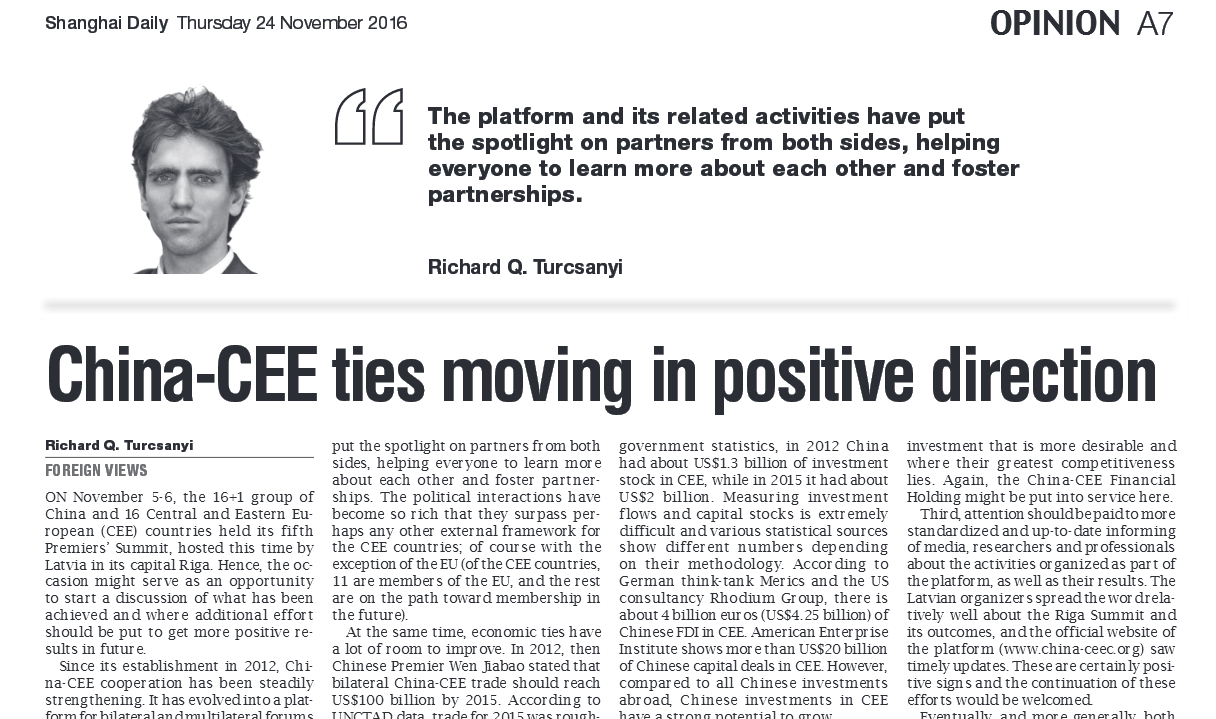Author: Release date:2016-12-20 15:01:27Source:发展研究院英文

ON November 5-6, the 16+1 group of China and 16 Central and Eastern European (CEE) countries held its fifth Premiers’ Summit, hosted this time by Latvia in its capital Riga. Hence, the occasion might serve as an opportunity to start a discussion of what has been achieved and where additional effort should be put to get more positive results in future.
Since its establishment in 2012, China-CEE cooperation has been steadily strengthening. It has evolved into a platform for bilateral and multilateral forums involving regular high level meetings of premiers and ministers, work sessions between officials, dynamic interactions between businesspeople, and numerous other people-to-people exchanges. The CEE countries have reached their highest level of interaction with China in history.
The development of China-CEE relations has been applauded by many politicians and observers. The CEE countries and China did not have many opportunities to become familiar with each other in their earlier history. The platform and its related activities have put the spotlight on partners from both sides, helping everyone to learn more about each other and foster partnerships. The political interactions have become so rich that they surpass perhaps any other external framework for the CEE countries; of course with the exception of the EU (of the CEE countries, 11 are members of the EU, and the rest are on the path toward membership in the future).
At the same time, economic ties have a lot of room to improve. In 2012, then Chinese Premier Wen Jiabao stated that bilateral China-CEE trade should reach US$100 billion by 2015. According to UNCTAD data, trade for 2015 was roughly US$80 billion, leaving plenty of space for growth, especially when it comes to promoting CEE exports to China.
Other views of the trade statistics re-emphasize this message. The CEE share in overall Chinese imports have been stagnant since 2012, although it had been consistently increasing in the decade prior to that year. At the same time, trade between China and Western Europe increased rapidly. Again, this shows that there is a huge potential to boost China-CEE trade.
The same is true with foreign direct investment. According to Chinese government statistics, in 2012 China had about US$1.3 billion of investment stock in CEE, while in 2015 it had about US$2 billion. Measuring investment flows and capital stocks is extremely difficult and various statistical sources show different numbers depending on their methodology. According to German think-tank Merics and the US consultancy Rhodium Group, there is about 4 billion euros (US$4.25 billion) of Chinese FDI in CEE. American Enterprise Institute shows more than US$20 billion of Chinese capital deals in CEE. However, compared to all Chinese investments abroad, Chinese investments in CEE have a strong potential to grow.
Here are some proposals to boost two-way trade and investment.
First, there have been a number of measures in place to facilitate CEE exports to China but perhaps more new initiatives can be explored. Possibly, the newly formed China-CEE Financial Holding, which was announced as one of the major outcomes of the recent Riga Summit, will direct its activities in this direction.
Second, Chinese investment activity in the region has focused on acquisitions and infrastructure building. However, for most CEE countries, it is greenfield investment that is more desirable and where their greatest competitiveness lies. Again, the China-CEE Financial Holding might be put into service here.
Third, attention should be paid to more standardized and up-to-date informing of media, researchers and professionals about the activities organized as part of the platform, as well as their results. The Latvian organizers spread the word relatively well about the Riga Summit and its outcomes, and the official website of the platform (www.china-ceec.org) saw timely updates. These are certainly positive signs and the continuation of these efforts would be welcomed.
Eventually, and more generally, both sides should adopt long-term plans and realistic views. Five years of China-CEE cooperation do not require final results to be achieved in one step, but they do ask members to make small steps in the right direction. The platform has been able to do that, and it is the hope of many observers in Europe and China that it will continue doing so.
Richard Q. Turcsanyi is visiting scholar at Fudan Development Institute, deputy director at Institute of Asian Studies, Bratislava, and assistant professor at Mendel University in Brno, Czech Republic.
For PDF version: ![]() Richard Q. Turcsanyi China-CEE ties moving in positive direction.pdf
Richard Q. Turcsanyi China-CEE ties moving in positive direction.pdf